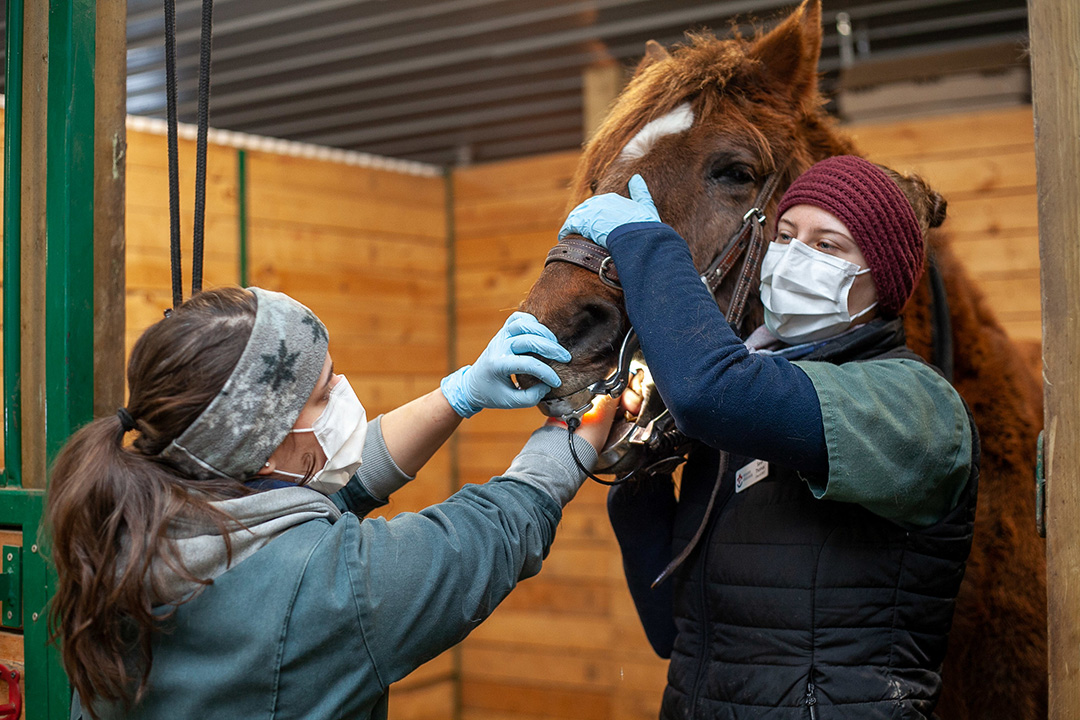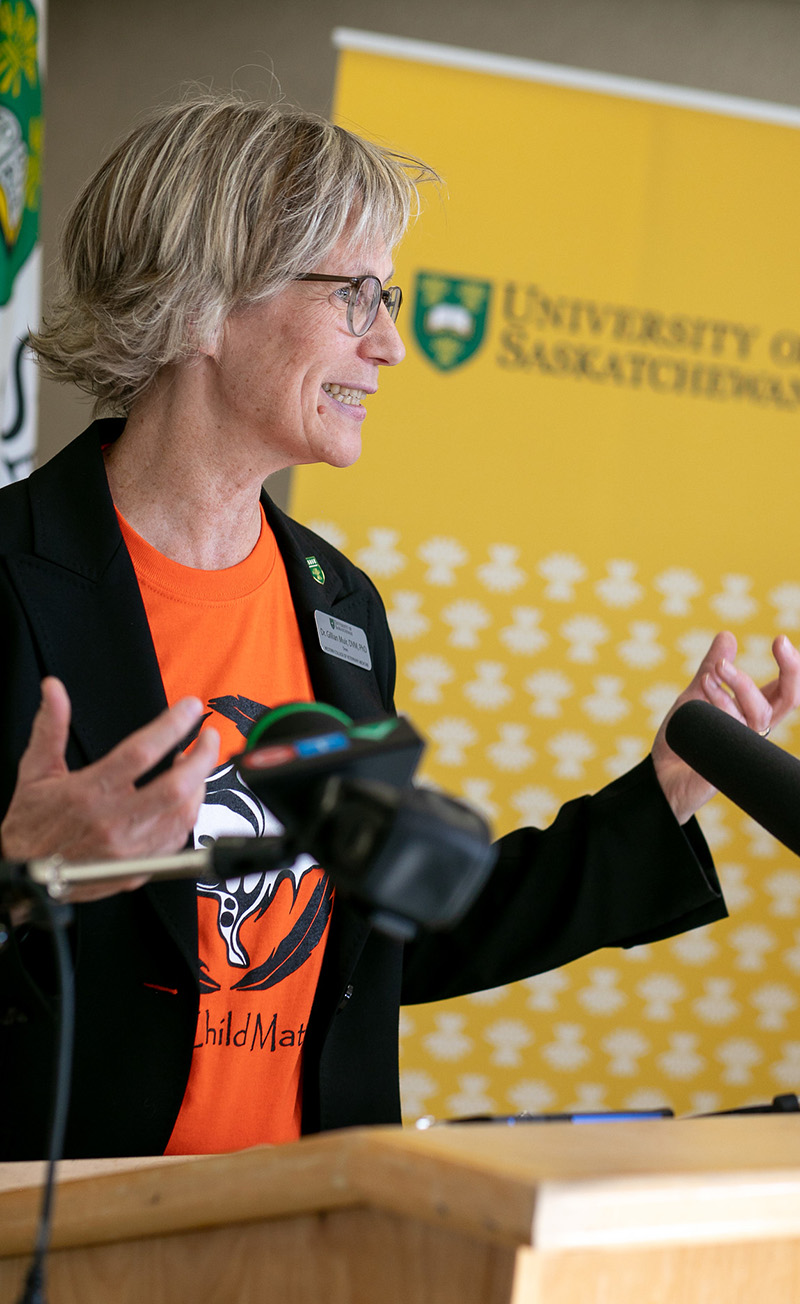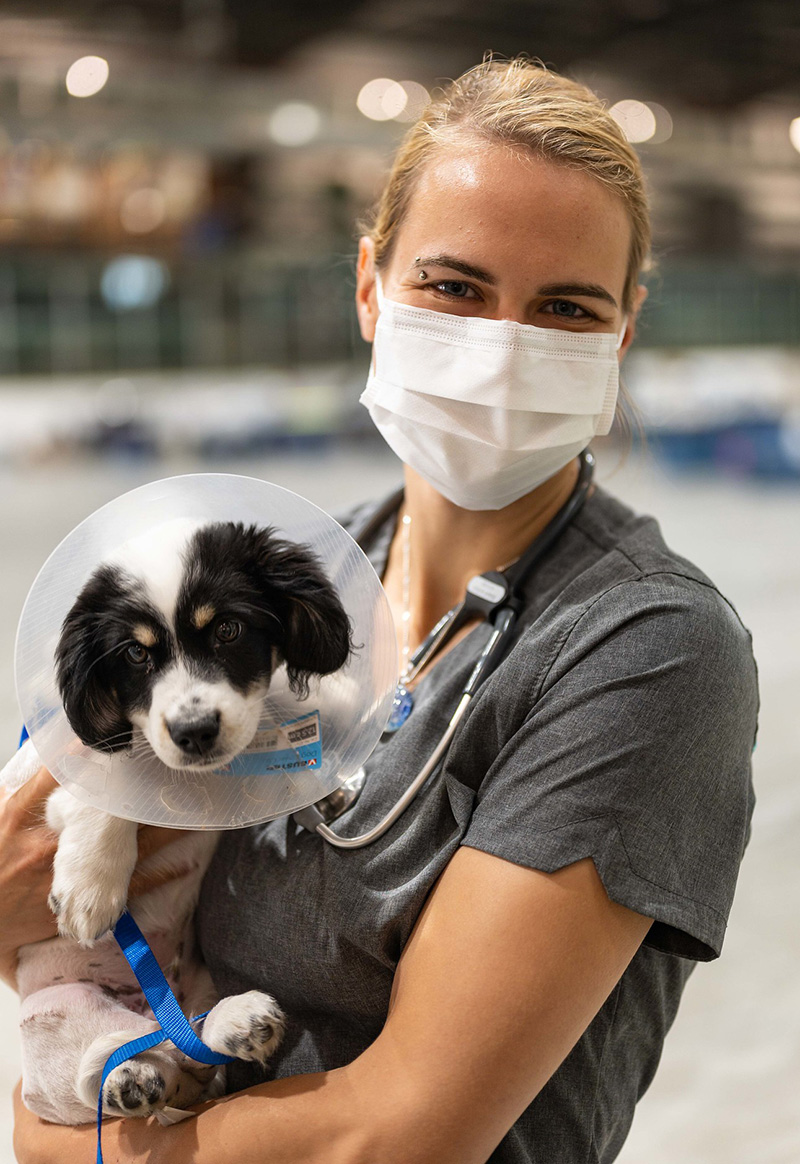
WCVM plays key role in addressing national veterinary shortage
Six decades ago, the University of Saskatchewan’s (USask) selection as the future home of a veterinary college serving Western Canada made the front page of The Saskatoon Star Phoenix—welcome news for a region suffering from a critical lack of veterinarians. And once the Western College of Veterinary Medicine (WCVM) officially opened in 1969, its provincial funding partners gave it a clear mandate: produce more vets for the West.
By Myrna MacDonaldSince then, the WCVM has consistently met that goal with more than 3,000 veterinarians to its credit and over 80 per cent of recent graduates living and working in Western Canada.

Still, WCVM Dean Dr. Gillian Muir (DVM, PhD) is dealing with a similar challenge today that faced her predecessors in the 1960s. Several factors—including a dramatic uptick in pet ownership during the COVID-19 pandemic—have led to a shortage of veterinary professionals, not only in Western Canada but across North America.
According to a 2020 workforce study conducted by the Canadian Veterinary Medical Association (CVMA), the country’s population of about 13,000 veterinarians must rise by at least four per cent per year to meet the growing demand. But Canada’s five veterinary colleges only graduate about 450 practitioners per year—enough to cover essentially only those retiring from the profession.
“We’ve been under-producing veterinarians in Canada for many decades now, and there has been a growing shortage of veterinarians in rural practice since the 1990s,” said Muir, a 1988 WCVM graduate who has led the college since 2020. “During COVID, the situation has become much more acute. Now we have shortages in all areas of veterinary medicine—not just in large animal practice.”
In response, the WCVM recently increased the class size for its Doctor of Veterinary Medicine (DVM) program from 78 to 88 seats—the college’s maximum capacity for its current facilities and resources. As the only Canadian college that administers the country’s clinical proficiency examination (CPE) program for international veterinary graduates, the WCVM is also working with the CVMA to expand the program’s intake. The CPE program places up to 55 qualified veterinarians into the profession each year.
In 2022, the urgent need for more veterinarians also motivated the WCVM’s provincial partners—British Columbia, Saskatchewan and Manitoba—to boost their financial support through the college’s Interprovincial Agreement (IPA).
“Their increased support is significant. It’s a recognition of the value that the college brings to our partner provinces … WCVM is their veterinary school and they rely on us to train their vet professionals,” said Muir.
In April 2022, the Government of B.C. doubled its number of seats in the college’s DVM program from 20 to 40 for the 2022/23 academic year. Six months later the Governments of Saskatchewan and Manitoba announced increased funding for the WCVM, enabling each province to boost its student seat quota by five.

This fall, Saskatchewan will have 25 seats in the college’s first-year class while Manitoba will have 20 students. As for B.C., it will confirm by March 2023 whether it will continue supporting 40 seats for the upcoming school year.
If B.C. does maintain its higher level of funding for the college, Muir explains that all of the WCVM’s 88 seats will be supported by the partner provinces. This scenario will also put the WCVM’s finances on its most secure footing since 2017—the era before the Government of Alberta decided to transfer financial support from the WCVM to the University of Calgary’s Faculty of Veterinary Medicine.
“It replaces that [Alberta] funding and more because our college’s number of DVM seats has grown from 78 to 88 since 2017. And so, those new 10 seats are now funded by increased support from Manitoba and Saskatchewan,” said Muir.
“It’s good timing—we’re not in survival mode anymore. We’re looking to the future and how we can best serve our communities.”
Muir points out that regular meetings between the college and its provincial funders have helped to bring about positive change. For example, based on input from the provinces, the WCVM is now offering “agriculture-focused” seats in its veterinary program to address the shortage of veterinarians in rural and remote communities. These provincial seats are designated for candidates who, based on their academic backgrounds and work experience, are more likely to practise in large animal or mixed animal clinics located in rural communities.
Another recent development is an increase in the number of annual seats that the WCVM allocates to Indigenous students in its veterinary program—a priority shared by the college and USask, as well as the WCVM’s provincial partners. While continuing to meet the college’s admissions standards, this initiative helps to address inequities in access to education for Indigenous people. In addition to two existing education equity seats, each province will now support one spot for a total of five Indigenous seats.
“We’ve been very, very open and engaged with our provincial funding partners, with the provincial veterinary medical associations, with the agriculture industry and with other stakeholders. They understand the needs of the veterinary program, and we understand needs across the provinces,” said Muir.
Those productive discussions prompted the college to begin a feasibility study last fall. Its goal is to determine what it will take to increase the number of veterinarians graduating from the WCVM—one solution to addressing the veterinary shortage across the country.
“We’re one of the gateways to veterinary education for Canadians, and it’s our responsibility to see how we can address this shortage. It wouldn’t be socially responsible if we decided to remain as a small school,” Muir said, noting that the WCVM is among the smallest veterinary schools in North America based on student population.
For the feasibility study, a WCVM team is conducting an analysis of the college’s DVM program.
“We’re looking at the logistics, spaces, schedules and resources we’ve got now, and then we’re extrapolating to determine what we would need to have in place to support a larger class size,” said Muir.
The WCVM is also exploring other modes of delivering its four-year veterinary program, particularly for the students’ first two “pre-clinical” years and their fourth year of clinical practice that mainly takes place in the WCVM’s Veterinary Medical Centre (VMC). In addition to providing primary veterinary care and emergency services for small and large animal patients, the VMC serves as Western Canada’s veterinary referral centre—similar to the role that Saskatoon’s Royal University Hospital plays in human medicine.
“Having our own veterinary teaching hospital is a robust and effective way to equitably train our veterinary students and to train veterinary professionals in specialty practice. It’s critical to our mandate as a centre of veterinary expertise, and it’s a commitment to the community, both locally and across Western Canada,” said Muir. “Many of the college’s donors who support the college do so because of the VMC, and for some people, the only reason they come on campus is to take their animals to the vet hospital.”
Any increase in the WCVM’s veterinary class size would require an expansion in the hospital, especially in extremely busy areas such as the VMC’s small animal emergency and critical care service that has long outgrown its existing space.
Muir adds that a thriving research program is also a vital part of the college’s mandate.
“The research work we do is absolutely relevant to the world that we’re living in today,” said Muir, pointing to the college’s infectious disease research as one example. “The research we are doing will improve health outcomes for animals and people together.
She adds that having a veterinary school alongside the USask College of Agriculture and Bioresources and a full range of health science colleges and research facilities on campus allows both WCVM and USask researchers to conduct more in-depth investigations of animal health issues as well as basic biomedical and One Health-focused questions.
Once the feasibility study wraps up, Muir will share results with the college’s provincial partners and key stakeholders and talk about next steps. She’s expecting an engaged discussion, especially since everyone around the table is very familiar with the issue—much like another group that gathered 60 years ago to discuss the creation of a western Canadian veterinary college.

